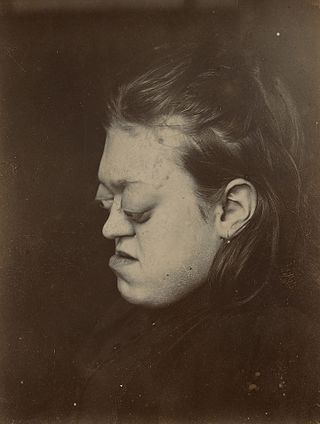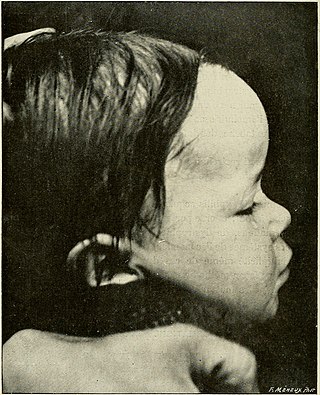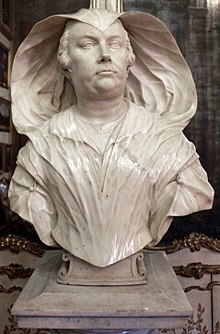
Cardiofaciocutaneous (CFC) syndrome is an extremely rare genetic disorder, and is one of the RASopathies. It was first described in 1986.

Exophthalmos is a bulging of the eye anteriorly out of the orbit. Exophthalmos can be either bilateral or unilateral. Complete or partial dislocation from the orbit is also possible from trauma or swelling of surrounding tissue resulting from trauma.

Saethre–Chotzen syndrome (SCS), also known as acrocephalosyndactyly type III, is a rare congenital disorder associated with craniosynostosis. This affects the shape of the head and face, resulting in a cone-shaped head and an asymmetrical face. Individuals with SCS also have droopy eyelids (ptosis), widely spaced eyes (hypertelorism), and minor abnormalities of the hands and feet (syndactyly). Individuals with more severe cases of SCS may have mild to moderate intellectual or learning disabilities. Depending on the level of severity, some individuals with SCS may require some form of medical or surgical intervention. Most individuals with SCS live fairly normal lives, regardless of whether medical treatment is needed or not.

Axenfeld–Rieger syndrome is a rare autosomal dominant disorder, which affects the development of the teeth, eyes, and abdominal region.
Aarskog–Scott syndrome (AAS) is a rare disease inherited as X-linked and characterized by short stature, facial abnormalities, skeletal and genital anomalies. This condition mainly affects males, although females may have mild features of the syndrome.

3C syndrome is a rare condition whose symptoms include heart defects, cerebellar hypoplasia, and cranial dysmorphism. It was first described in the medical literature in 1987 by Ritscher and Schinzel, for whom the disorder is sometimes named.
Weaver syndrome is an extremely rare autosomal dominant genetic disorder associated with rapid growth beginning in the prenatal period and continuing through the toddler and youth years. It is characterized by advanced osseous maturation and distinctive craniofacial, skeletal and neurological abnormalities. It is similar to Sotos syndrome and is classified as an overgrowth syndrome.

Frontonasal dysplasia (FND) is a congenital malformation of the midface. For the diagnosis of FND, a patient should present at least two of the following characteristics: hypertelorism, a wide nasal root, vertical midline cleft of the nose and/or upper lip, cleft of the wings of the nose, malformed nasal tip, encephalocele or V-shaped hair pattern on the forehead. The cause of FND remains unknown. FND seems to be sporadic (random) and multiple environmental factors are suggested as possible causes for the syndrome. However, in some families multiple cases of FND were reported, which suggests a genetic cause of FND.

Tricho-hepato-enteric syndrome (THE), also known as syndromic or phenotypic diarrhea, is an extremely rare congenital bowel disorder which manifests itself as intractable diarrhea in infants with intrauterine growth retardation, hair and facial abnormalities. Many also have liver disease and abnormalities of the immune system. The associated malabsorption leads to malnutrition and failure to thrive.

Triangular alopecia is hair loss that may be congenital but usually appears in childhood as a focal patch of loss that may be complete or leaving fine vellus hairs behind. Affected individuals are typically entirely healthy. Hair restoration surgery using follicular unit transplantation has been a successful treatment modality for TTA

Donnai–Barrow syndrome is a genetic disorder first described by Dian Donnai and Margaret Barrow in 1993. It is associated with LRP2. It is an inherited (genetic) disorder that affects many parts of the body.
Nasodigitoacoustic syndrome, also called Keipert syndrome, is a rare congenital syndrome first described by J.A. Keipert and colleagues in 1973. The syndrome is characterized by a misshaped nose, broad thumbs and halluces, brachydactyly, sensorineural hearing loss, facial features such as hypertelorism, and developmental delay.

Goldberg–Shprintzen is a very rare connective tissue condition associated with mutations in KIAA1279 gene which encodes KIF-binding protein (KBP), a protein that may interact with microtubules and actin filaments. KBP may play a key role in cytoskeleton formation and neurite growth.
Opitz G/BBB syndrome, also known as Opitz syndrome, G syndrome or BBB syndrome, is a rare genetic disorder that will affect physical structures along the midline of the body. The letters G and BBB represent the last names of the families that were first diagnosed with the disorder, while Opitz is the last name of the doctor that first described the signs and symptoms of the disease. There are two different forms of Optiz G/BBB syndrome: x-linked (recessive) syndrome and dominant autosomal syndrome. However, both result in common physical deformities, although their pattern of inheritance may differ. Several other names for the disease(s) are no longer used. These include hypospadias-dysphagia syndrome, Opitz-Frias syndrome, telecanthus with associated abnormalities, and hypertelorism-hypospadias syndrome.
Professor Dian Donnai is a British medical geneticist.

Pascual-Castroviejo syndrome type 1 is a rare autosomal recessive condition characterized by facial dysmorphism, cognitive impairment and skeletal anomalies.
Ankyloblepharon is a medical condition, defined as the adhesion of the edges of the upper eyelid with the lower eyelid. Ankyloblepharon must be differentiated from blepharophimosis, in which palpebral aperture is reduced and there is telecanthus, but the eyelid margins are normal. Another condition similar to ankyloblepharon is symblepharon, in which the palpebral conjunctiva is attached to the bulbar conjunctiva. Recognition of ankyloblepharon necessitates systemic examination to detect associated abnormalities such as genitourinary and cardiac abnormalities and syndactyly.

SOFT syndrome, also known for the name its acronym originates from: Short stature-onychodysplasia-facial dysmorphism-hypotrichosis syndrome, is a rare genetic disorder characterized by the presence of short stature, underdeveloped nails, facial dysmorphisms, and hair sparcity across the body. It is caused by homozygous, autosomal recessive mutations in the POC1A gene, located in the short arm of chromosome 3. Fewer than 15 cases have been described in the medical literature.

High anterior hairline is a dysmorphic feature in which the frontal hairline which defines the top and sides of the forehead is unusually high. This can mean that either the distance between the trichion (hairline) and glabella is more than 2 SD above the mean, or that this distance is apparently (subjectively) increased.











